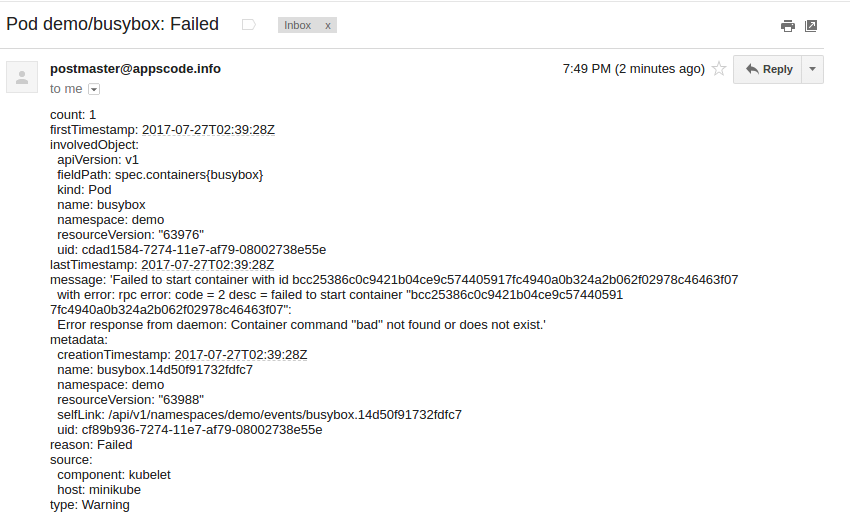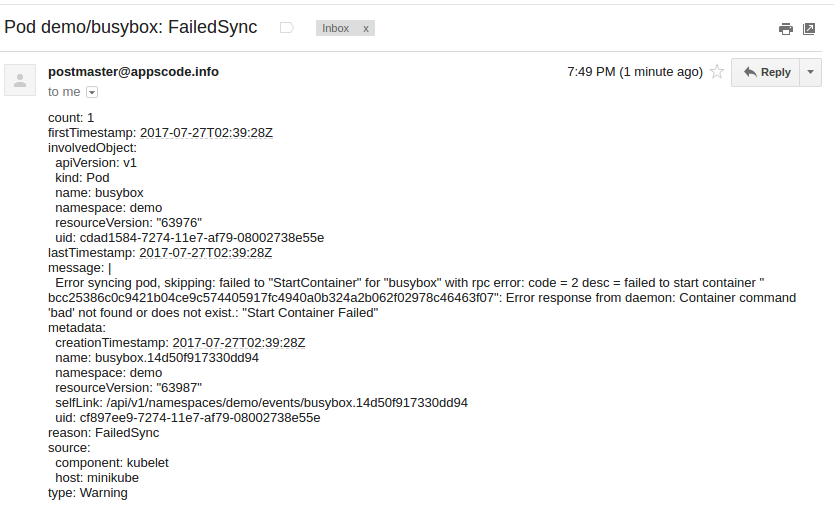You are looking at the documentation of a prior release. To read the documentation of the latest release, please
visit here.
New to Kubed? Please start here.
Forward Cluster Events
Kubed can send notifications via Email, SMS or Chat for various cluster events. This document will show you how to use Kubed to setup an event forwarder.
Before You Begin
At first, you need to have a Kubernetes cluster, and the kubectl command-line tool must be configured to communicate with your cluster. If you do not already have a cluster, you can create one by using Minikube.
Deploy Kubed
To enable config syncer, you need a cluster config like below.
$ cat ./docs/examples/event-forwarder/config.yaml
clusterName: unicorn
eventForwarder:
receivers:
- notifier: Mailgun
to:
- ops@example.com
rules:
# notify for warning events in kube-system namespace
- namespaces:
- kube-system
operations:
- CREATE
resources:
- group: "" # core API group
resources:
- events
# notify for both CREATE and DELETE operations in any namespace
- resources:
- group: "" # core API group
resources:
- nodes
- persistentvolumes
- persistentvolumeclaims
- group: storage.k8s.io
resources:
- storageclasses
- group: extensions
resources:
- ingresses
- group: voyager.appscode.com
resources:
- ingresses
- group: certificates.k8s.io
resources:
- certificatesigningrequests
notifierSecretName: notifier-config
The configuration format is inpired by audit policy file format. The policy is defined here. The matcher logic is implemented here.
NB: The event forwarder configuration format has been redesigned in 0.8.0 and should be updates accordingly if you are upgrading from a previous version.
Now, create a Secret with the Kubed cluster config under config.yaml key.
$ kubectl create secret generic kubed-config -n kube-system \
--from-file=./docs/examples/event-forwarder/config.yaml
secret "kubed-config" created
# apply app=kubed label to easily cleanup later
$ kubectl label secret kubed-config app=kubed -n kube-system
secret "kubed-config" labeled
$ kubectl get secret kubed-config -n kube-system -o yaml
apiVersion: v1
data:
config.yaml: ZXZlbnRGb3J3YXJkZXI6CiAgbm9kZUFkZGVkOgogICAgaGFuZGxlOiB0cnVlCiAgc3RvcmFnZUFkZGVkOgogICAgaGFuZGxlOiB0cnVlCiAgaW5ncmVzc0FkZGVkOgogICAgaGFuZGxlOiB0cnVlCiAgd2FybmluZ0V2ZW50czoKICAgIGhhbmRsZTogdHJ1ZQogICAgbmFtZXNwYWNlczoKICAgIC0ga3ViZS1zeXN0ZW0KICByZWNlaXZlcjoKICAgIG5vdGlmaWVyOiBtYWlsZ3VuCiAgICB0bzoKICAgIC0gb3BzQGV4YW1wbGUuY29tCm5vdGlmaWVyU2VjcmV0TmFtZToga3ViZWQtbm90aWZpZXIK
kind: Secret
metadata:
creationTimestamp: 2017-07-27T05:35:54Z
labels:
app: kubed
name: kubed-config
namespace: kube-system
resourceVersion: "70583"
selfLink: /api/v1/namespaces/kube-system/secrets/kubed-config
uid: 753220c3-728d-11e7-87f5-08002738e55e
type: Opaque
Now, deploy Kubed operator in your cluster following the steps here. Once the operator pod is running, go to the next section.
Test Forwarder
To keep things isolated, this tutorial uses a separate namespace called demo throughout this tutorial. Run the following command to prepare your cluster for this tutorial:
$ kubectl create namespace demo
namespace "demo" created
~ $ kubectl get namespaces
NAME STATUS AGE
default Active 6h
kube-public Active 6h
kube-system Active 6h
demo Active 4m
Forward Storage Added Event
In this section, a PVC will be used to show how event forwarder feature can be used. Create a PVC called myclaim in the demo namespace.
$ kubectl apply -f ./docs/examples/event-forwarder/demo-0.yaml
persistentvolumeclaim "myclaim" configured
$ kubectl get pvc myclaim -n demo -o yaml
apiVersion: v1
kind: PersistentVolumeClaim
metadata:
annotations:
control-plane.alpha.kubernetes.io/leader: '{"holderIdentity":"a56b7269-71ef-11e7-af79-08002738e55e","leaseDurationSeconds":15,"acquireTime":"2017-07-27T01:24:08Z","renewTime":"2017-07-27T01:24:10Z","leaderTransitions":0}'
kubectl.kubernetes.io/last-applied-configuration: |
{"apiVersion":"v1","kind":"PersistentVolumeClaim","metadata":{"annotations":{},"name":"myclaim","namespace":"demo"},"spec":{"accessModes":["ReadWriteOnce"],"resources":{"requests":{"storage":"50Mi"}},"storageClassName":"standard"}}
pv.kubernetes.io/bind-completed: "yes"
pv.kubernetes.io/bound-by-controller: "yes"
volume.beta.kubernetes.io/storage-provisioner: k8s.io/minikube-hostpath
creationTimestamp: 2017-07-27T01:24:08Z
name: myclaim
namespace: demo
resourceVersion: "58641"
selfLink: /api/v1/namespaces/demo/persistentvolumeclaims/myclaim
uid: 49b9851c-726a-11e7-af79-08002738e55e
spec:
accessModes:
- ReadWriteOnce
resources:
requests:
storage: 50Mi
storageClassName: standard
volumeName: pvc-49b9851c-726a-11e7-af79-08002738e55e
status:
accessModes:
- ReadWriteOnce
capacity:
storage: 50Mi
phase: Bound
Now, assuming you configured a GMail account as the receiver for events, you should see an email like below:

Forward Warning Events
In this section, a Busybox pod will be used to show how warning events are forwarded. Create a Pod called busybox in the demo namespace.
$ cat ./docs/examples/event-forwarder/demo-1.yaml
apiVersion: v1
kind: Pod
metadata:
name: busybox
namespace: demo
spec:
restartPolicy: Never
containers:
- name: busybox
image: busybox
imagePullPolicy: IfNotPresent
command:
- bad
- "3600"
$ kubectl apply -f ./docs/examples/event-forwarder/demo-1.yaml
pod "busybox" created
$ kubectl get pods -n demo --show-all
NAME READY STATUS RESTARTS AGE
busybox 0/1 rpc error: code = 2 desc = failed to start container "bcc25386c0c9421b04ce9c574405917fc4940a0b324a2b062f02978c46463f07": Error response from daemon: Container command 'bad' not found or does not exist. 0 10m
Here, the busybox pod fails to start because it uses a missing command called bad. This results in 2 Warning events. Now, check your GMail account. You should receive 2 emails like below.


Supported Kubernetes Objects
Following Kubernetes objects are supported by event forwarder:
- v1:
- ConfigMap
- Event
- LimitRange
- Namespace
- Node
- PersistentVolume
- PersistentVolumeClaim
- ReplicationController
- Secret
- Service
- ServiceAccount
- apps/v1beta1:
- Deployment
- StatefulSet
- batch/v1:
- Job
- batch/v1beta1:
- CronJob
- extensions/v1beta1:
- Deployment
- Ingress
- ReplicaSet
- networking.k8s.io/v1:
- NetworkPolicy
- kubedb/v1alpha1:
- DormantDatabase
- Elasticsearch
- Memcached
- MongoDB
- MySQL
- Postgres
- Redis
- Snapshot
- monitoring.coreos.com/v1:
- Prometheus
- ServiceMonitor
- Alertmanager
- rbac/v1:
- ClusterRole
- ClusterRoleBinding
- Role
- RoleBinding
- monitoring.appscode.com/v1alpha1:
- ClusterAlert
- NodeAlert
- PodAlert
- stash.appscode.com/v1alpha1:
- Restic
- Recovery
- storage/v1:
- StorageClass
- voyager.appscode.com/v1beta1:
- Certificate
- Ingress
To add support for additional object types, please file an issue.
Disable Event Forwarder
If you would like to disable this feature, remove the eventForwarder portion of your Kubed cluster config. Then update the kubed-config Secret and restart Kubed operator pod(s).
Cleaning up
To cleanup the Kubernetes resources created by this tutorial, run the following commands:
$ kubectl delete pvc myclaim -n demo
persistentvolumeclaim "myclaim" deleted
$ kubectl delete ns demo
namespace "demo" deleted
To uninstall Kubed operator, please follow the steps here.
Next Steps
- See the list of supported notifiers here.
- Learn how to use Kubed to protect your Kubernetes cluster from disasters here.
- Need to keep configmaps/secrets synchronized across namespaces or clusters? Try Kubed config syncer.
- Out of disk space because of too much logs in Elasticsearch or metrics in InfluxDB? Configure janitors to delete old data.
- Wondering what features are coming next? Please visit here.
- Want to hack on Kubed? Check our contribution guidelines.









